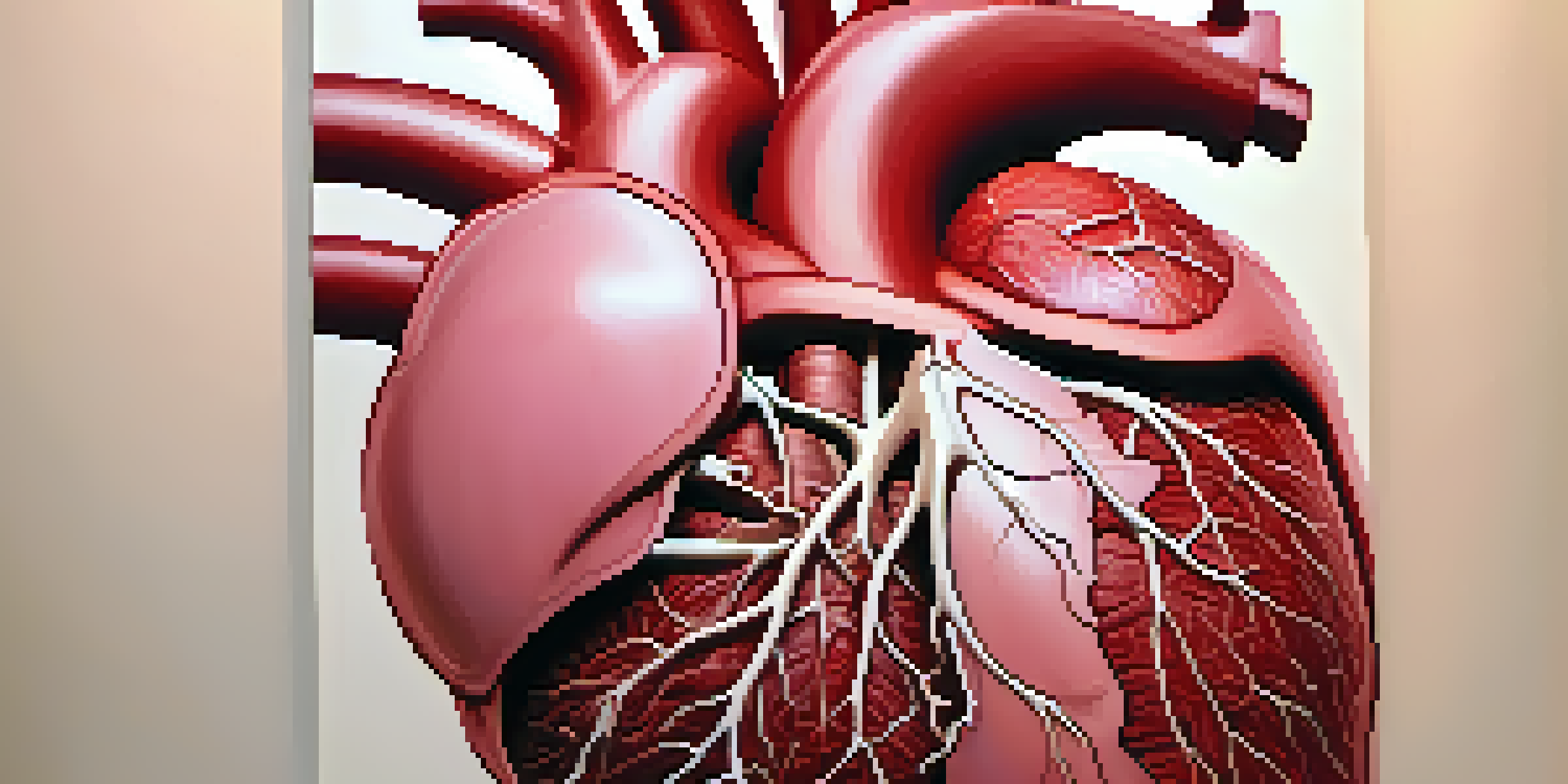The Inner Body: Representations in Medical and Conceptual Art

Understanding the Inner Body: A Medical Perspective
The inner body encompasses all the organs and systems that keep us alive, functioning behind the scenes. From the beating heart to the intricate web of neurons in the brain, these structures are often unseen yet vital. Medical science has advanced our understanding of these components, allowing us to visualize them through technologies like MRI and CT scans.
The body is a sacred garment.
These imaging techniques not only help doctors diagnose ailments but also offer a glimpse into the body's complex architecture. They serve as a bridge between art and science, transforming the invisible into images that can be studied and appreciated. For instance, an MRI scan can resemble a work of art, showcasing the beauty of the human form in its most functional state.
Through these medical representations, we gain insight into how our bodies operate, leading to greater appreciation for our health. This knowledge empowers us to take better care of ourselves, highlighting the intricate design of our inner workings. Ultimately, understanding the inner body is not just about anatomy; it's about recognizing the marvel of life itself.
Artistic Representations of the Inner Body
Artists have long been fascinated by the human body, often using it as a canvas to explore deeper themes of existence and mortality. From the detailed anatomical drawings of Leonardo da Vinci to contemporary installations, the inner body has inspired countless works. These artistic representations challenge viewers to engage with the concept of the body beyond its physical form.

By interpreting the inner body through art, creators provoke thought and evoke emotion, making the unseen visible. For example, the use of vivid colors and abstract shapes can illustrate the complexity of human emotions tied to physical health. This artistic license allows a deeper connection with the viewer, inviting them to reflect on their own experiences and vulnerabilities.
Art and Science Unite in Health
The integration of artistic representations and medical imaging enhances our understanding of the inner body and promotes health awareness.
Moreover, these artworks often serve as a commentary on medical practices, questioning the relationship between science and humanity. This dialogue between art and medicine enriches our understanding of the human experience, emphasizing the importance of both fields in nurturing our well-being and identity.
Conceptual Art and the Inner Body: A New Dimension
Conceptual art pushes boundaries, inviting viewers to think critically about the notion of the inner body. By focusing on ideas rather than just aesthetics, artists can explore themes like identity, illness, and healing. This genre often incorporates multimedia elements, allowing for a richer exploration of what the inner body represents in our lives.
Art is the most beautiful of all lies.
For instance, installations that combine sound, light, and video can simulate the experience of surgery or the sensations of illness, enabling viewers to empathize with the realities of the human condition. This immersive approach not only captivates the audience but also educates them about bodily experiences that are often overlooked. In this way, conceptual art becomes a powerful tool for storytelling.
Ultimately, this blend of art and conceptual thought challenges societal perceptions of health and the body. It encourages us to consider our inner selves, fostering a sense of unity and understanding among individuals. By contemplating these representations, we can better appreciate the diversity of human experiences related to the inner body.
The Role of Technology in Representing the Inner Body
Technology has transformed how we visualize the inner body, with advancements in imaging techniques revolutionizing medical practice. Tools like 3D modeling and virtual reality allow for an interactive exploration of anatomical structures. These innovations not only aid in diagnosis but also enhance medical education by providing students with realistic simulations.
Artists have embraced these technological advancements, incorporating them into their work to create dynamic representations of the body. For example, digital art can depict the inner workings of the heart in real time, merging art with scientific accuracy. This fusion creates a unique experience that captivates and educates an audience, blurring the lines between disciplines.
Cultural Views Shape Health Perceptions
Different cultural interpretations of the inner body highlight diverse approaches to health, emphasizing the importance of context in medical practices.
As technology continues to evolve, so too will the ways we represent the inner body. This ongoing relationship between art and technology invites endless possibilities for creativity and innovation. The future of these representations promises to deepen our understanding of ourselves, both physically and conceptually.
Cultural Representations of the Inner Body
Different cultures have unique perspectives on the inner body, often reflected in their art and medical practices. Traditional healing systems, such as Ayurveda or Traditional Chinese Medicine, emphasize a holistic view of health, integrating body, mind, and spirit. These approaches often inspire artistic interpretations that depict the body as interconnected rather than merely a collection of parts.
For example, indigenous art may symbolize the body through nature, using elements like roots or rivers to represent the flow of energy and life. This cultural lens encourages a deeper understanding of how various societies perceive health and well-being, highlighting the importance of context in medical practices. Such representations remind us that the inner body is not just a biological entity but also a cultural construct.
By exploring these diverse representations, we can appreciate the richness of human experience and the various ways we relate to our bodies. This appreciation fosters respect for different healing traditions and promotes a more inclusive approach to health. Ultimately, acknowledging cultural perspectives on the inner body enhances our collective understanding of what it means to be human.
The Impact of Inner Body Representations on Health Awareness
Artistic representations of the inner body play a significant role in raising health awareness. By visualizing complex medical concepts and conditions, artists can communicate important health messages in an engaging way. This can be particularly effective in public health campaigns, where visual art captures attention and sparks conversations about health issues.
For example, graphic illustrations that depict the effects of smoking on the lungs can have a profound impact on viewers. These visuals not only educate but also evoke emotional responses, encouraging individuals to reflect on their health choices. Such representations serve as powerful reminders of the importance of self-care and preventative measures.
Future of Inner Body Representation
Emerging technologies and interdisciplinary collaborations are shaping innovative ways to explore and understand the inner body, enriching both art and medicine.
As art continues to intersect with health, we can expect a growing emphasis on the inner body in public discourse. This movement encourages us to prioritize our well-being and fosters a more informed society. By engaging with both art and science, we can cultivate a deeper understanding of health and the human experience.
Future Directions in Inner Body Art and Medical Representation
As we look to the future, the intersection of art, medicine, and technology will continue to evolve, shaping how we understand the inner body. Emerging fields like bio-art are exploring live tissues and biological materials, pushing the boundaries of representation. These innovative practices challenge our perceptions of life and art, inviting us to consider the ethical implications of such creations.
Moreover, collaborations between artists and medical professionals are likely to increase, fostering cross-disciplinary dialogue. Such partnerships can lead to new educational tools that combine artistic expression with medical knowledge, making complex concepts more accessible. This trend could revolutionize medical training and patient education, bridging gaps between disciplines.

In this ever-evolving landscape, we must remain open to the possibilities that arise from these collaborations. The future of inner body representations holds great promise for enhancing our understanding of health, identity, and the human experience. By embracing these changes, we can foster a more holistic view of well-being that celebrates both art and science.